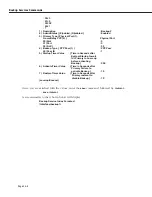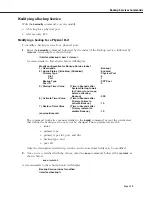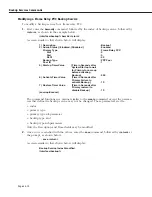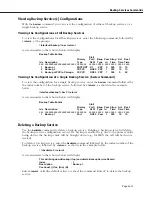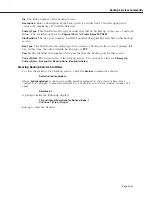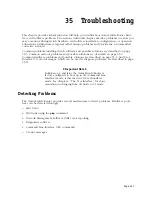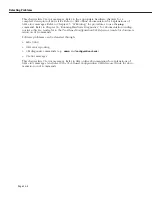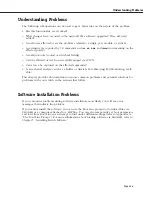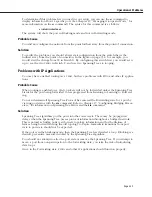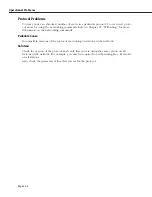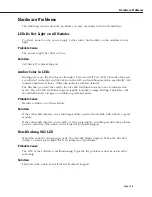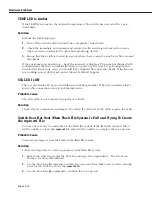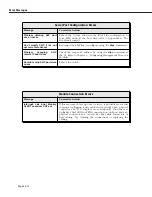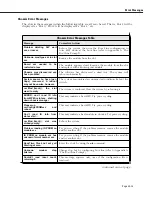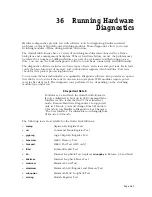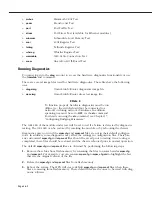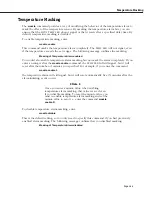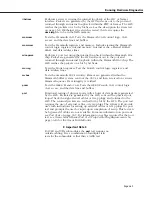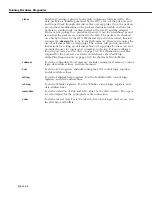
Operational Problems
Page 35-7
To determine if this problem has occurred in your setup, you can use the
vi
command to
display information about a specific port. (See Chapter 19, “Managing Groups and Ports,” for
more information on the
vi
command.) The syntax for this command is as follows:
vi <slot>/<interface>
The system will show the port in Blocking mode and not in Forwarding mode.
Probable Cause
You did not configure the network from the point furthest away from the point of connection.
Solution
To rectify the problem, you should always start configuration from the switch that is the
furthest away from the point of connection. In the figure on page 35-6, for example, you
would start the change from V2 in Switch X. By configuring this switch first, you would set it
up to see the two
VLANs
in Switch Y, and use two Spanning Trees to looping.
Problems with IP Applications
You may have enabled routing on a
VLAN
, but have problems with
PING
and other
IP
applica-
tions.
Probable Cause
When routing is enabled on a
VLAN
, packets will not be forwarded unless the Spanning Tree
Status for the port being forwarded to has progressed from Listening to Learning to Forward-
ing.
You can determine if Spanning Tree Protocol has entered the Forwarding state for a port by
viewing port status with the
sts
command. Refer to Chapter 17, “Configuring Bridging Param-
eters,” for information on Spanning Tree Status and the
sts
command.
Solution
Spanning Tree algorithms put the ports into the correct state. There may be propagation
delays when the Spanning Tree passes protocol information throughout a bridged network.
This is normal as bridge ports wait for new topology information and for the lifetime of
frames being forwarded using the old topology to expire. Immediate transitions from port
state to port state should not be expected.
If the port is in the blocking mode, then the Spanning Tree has detected a loop. Blocking is a
desired, preventive measure invoked by the Spanning Tree algorithm.
You should not attempt to alter the port state or remove the Spanning Tree. If you attempt to
move a port from non-participation to the forwarding state, you take the risk of introducing
data loops.
Once in the Forwarding state,
PINGs
and other
IP
applications should function properly.
Summary of Contents for Omni Switch/Router
Page 1: ...Part No 060166 10 Rev C March 2005 Omni Switch Router User Manual Release 4 5 www alcatel com ...
Page 4: ...page iv ...
Page 110: ...WAN Modules Page 3 40 ...
Page 156: ...UI Table Filtering Using Search and Filter Commands Page 4 46 ...
Page 164: ...Using ZMODEM Page 5 8 ...
Page 186: ...Displaying and Setting the Swap State Page 6 22 ...
Page 202: ...Creating a New File System Page 7 16 ...
Page 270: ...Displaying Secure Access Entries in the MPM Log Page 10 14 ...
Page 430: ...OmniChannel Page 15 16 ...
Page 496: ...Configuring Source Route to Transparent Bridging Page 17 48 ...
Page 542: ...Dissimilar LAN Switching Capabilities Page 18 46 ...
Page 646: ...Application Example DHCP Policies Page 20 30 ...
Page 660: ...GMAP Page 21 14 ...
Page 710: ...Viewing the Virtual Interface of Multicast VLANs Page 23 16 ...
Page 722: ...Application Example 5 Page 24 12 ...
Page 788: ...Viewing UDP Relay Statistics Page 26 24 ...
Page 872: ...The WAN Port Software Menu Page 28 46 ...
Page 960: ...Deleting a PPP Entity Page 30 22 ...
Page 978: ...Displaying Link Status Page 31 18 ...
Page 988: ...Displaying ISDN Configuration Entry Status Page 32 10 ...
Page 1024: ...Backup Services Commands Page 34 14 ...
Page 1062: ...Diagnostic Test Cable Schematics Page 36 24 ...
Page 1072: ...Configuring a Switch with an MPX Page A 10 ...
Page 1086: ...Page B 14 ...
Page 1100: ...Page I 14 Index ...


